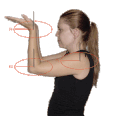Eshkol, N.; Harries, J.G., Sella, R., Sapir, T. The quest for T'ai Chi Chuan. Israel: The Movement Notation Society & Tel Aviv University; 1986. An EW reader and study of Cheng's short form of this martial art.
Eshkol, N.; Sapir, T., Sella, R., Harries, J.G., Shoshani, M. The quest for T'ai Chi Chuan. Israel: The Movement Notation Society & Tel Aviv University; 1988. Second and expanded edition. Includes three styles of the solo exercise of this martial art form.
Appel, A. Karate. Israel: Minimol Publisher, 1990.
Animal behavior
Golani, I. Homeostatic motor processes in mammalian interaction: A Choreography of Display. Perspectives in Ethology. 2: 1976.
Ganor, I.; Golani, I. Coordination and integration in the hindleg steps cycle of the rat: Kinematic Synergies. Brain Research 164; 1980.
Moran, G.; Fentress, J.C., Golani I. A description of the relational patterns of movement during ritualized fighting in wolves. Animal Behavior. 29:1146–1165; 1981.
Pellis, S. M. A description of social play by the Australian magpie gymnorhina tibicen based on Eshkol-Wachman notation. Bird Behaviour. 3:61–79; 1981
Pellis, S. M. An analysis of courtship and mating in the Cape Barren goose Cereopsis novaehollandiae latham based on Eshkol-Wachman movement notation. Bird Behaviour. 4:30–41; 1982.
Pellis, S. M. Development of head and foot coordination in the Australian Magpie gymnorhina tibicen, and the function of play. Bird Be haviour. 4: 57–62; 1983.
Pellis, S. M. What is "fixed" in a fixed action pattern? A problem of methodology. Bird Behaviour. 6: 10–15; 1985.
Whishaw, I. Q.; Kolb, B. The mating movements of male decorticate rats: evidence for subcortically generated movements by the male but regulation of approaches by the female. Behavioural Brain Research. 17: 171–191; 1985.
Pellis, S. M.; Officer, R. C. E. An analysis of some predatory behaviour patterns in four species of carnivorous marsupials (Dasyuridae), with comparative notes on the eutherian cat Felis catus. Ethology. 75: 177–196;1987.
Pellis, S. M.; Pellis, V. C., Chesire, R. M., Rowland, N. E., Teitelbaum, P. Abnormal gait sequence in the locomotion released by atropine in catecholamine deficient akinetic rats. Proc. of the National Academy of Sciences. 84: 8750–8753;1987.
Yaniv, Y.; Golani, I. Superiority and inferiority: A morphological analysis of free and stimulus bounds behavior in honey badger (Mellivora capensis) interactions. Ethology. 74:89–116 ; 1987.
Eilam, D.; Golani, G. The ontology of exploratory behavior in the house (Rattus Rattus): The mobility gradient. Developmental Psychobiology . 21(7):679–710; 1988.
Pellis, S. M.; O'Brien, D. P, Pellis, V. C., Teitelbaum, P., Wolgin, D. L., Kennedy, S. Escalation of feline predation along a gradient from avoidance through "play" to killing. Behavioral Neuroscience. 102:760–777; 1988.
Faulkes, Z. Sand crab digging: The neuroethology and evolution of a "new" behavior. B.Sc, University of Lethbridge. 1988.
Pellis, S. M. Fighting: the problem of selecting appropriate behavior patterns. Blanchard, R. J.; Brain, P. F., Blanchard, D. C., Parmigiani, S., Eds. Ethoexperimental Approaches to the Study of Behavior. 361–374; 1989.
Teitelbaum, P.; Pellis, S. M., DeVietti, T. L. Disintegration into stereotypy induced by drugs or brain damage: A micro-descriptive behavioral analysis. Cooper, S.J.; Dourish, C. T., Eds. Neurobiology of Behavioral Stereotypy. 169–199; 1990.
Whishaw, I. Q.; Pellis, S. M. The structure of skilled forelimb reaching in the rat: A proximally driven stereotyped movement with a single rotatory component. Behavioral Brain Research. 41: 49–59;1990.
Whishaw, I. Q.; Pellis, S. M., Gorny, B. P., Pellis, V. C. The impairments in reaching and the movements of compensation in rats with motor cortex lesions: A videorecording and movement notation analysis. Behavioural Brain Research. 42: 77–91; 1991.
Golani, I. A Mobility Gradient in the Organization of Vertebrate Movement: The Perception of Movement Through Symbolic Language. Behavioral and Brain Sciences. Vol 15(2): 249–308; 1992.
Whishaw, I. Q.; Pellis, S. M., Gorny, B. P. Skilled reaching in rats and humans: Evidence for parallel development or homology. Behavioural Brain Research. 47: 59- 70; 1992.
34. Whishaw, I. Q.; Dringenberg, H. C., Pellis, S. M. Forelimb use in free feeding by rats: Motor cortex aids limb and digit positioning. Behavioural Brain Research. 48: 113–125; 192.
Whishaw, I. Q.; Pellis, S. M., Gorny, B. P. Medial frontal cortex lesions impair the aiming component of rat reaching. Behavioural Brain Research. 50: 93–104;1992.
Whishaw, I. Q.; Pellis, S. M., Pellis, V. C. A behavioral study of the contributions of cells and fibers of passage in the red nucleus of the rat to postural righting, skilled movements, and learning. Behavioural Brain Research. 52: 29–44; 1992.
Whishaw, I. Q.; Pellis, S. M., Gorny, B., Kolb, B., Tetzlaff, W. Proximal and distal impairments in rat forelimb use in reaching following pyramidal tract lesions. Behavioural Brain Research. 56:59–76; 1993.
Whishaw, I. Q.; Gorny, B., Tran-Nguyen, L. T. L., Castañeda, E., Miklyaeva, E. I., Pellis, S. M. Doing two things at once: Impairments in movement and posture underlie the adult skilled reaching deficit of neonatally dopamine-depleted rats. Behavioural Brain Research. 61: 65–77; 1994.
Field, E. F.; Whishaw, I. Q., Pellis, S. M. An analysis of sex differences in the movement patterns used during the food wrenching and dodging paradigm. Journal of Comparative Psychology. 110: 298–306; 1996.
Ivanco, T. L.; Pellis, S. M., Whishaw, I. Q. Skilled movements in prey catching and in reaching by rats (Rattus norvegicus ) and opossums (Monodelphis domestica ): Relations to anatomical differences in motor systems. Behavioural Brain Research. 79: 163–182; 1996.
Pellis, S. M. Righting and the modular organization of motor programs. Ossenkopp, K.P.; Kavaliers, M., Sanberg, P.R., Eds. Measuring Movement and Locomotion: From Invertebrates to Humans. 115–133; 1996.
Faulkes, Z.; Paul, D. H. Digging in sand crabs (Decapoda, Anomura, Hippoidea): Interleg coordination. Journal of Experimental Biology. 200: 793–805;1997.
Field, E. F.; Whishaw, I. Q., Pellis, S. M. The organization of sex-typical patterns of defense during food protection in the rat: The role of the opponent's sex. Aggressive Behavior. 23: 197–214; 1997.
Field, E. F.; Whishaw, I. Q., Pellis, S. M. A kinematic analysis of sex-typical movement patterns used during evasive dodging to protect a food item: The role of gonadal androgens. Behavioral Neuroscience. 111: 808–815; 1997.
Iwaniuk, A. N.; Nelson, J. E., Ivanco, T. L., Pellis, S. M., Whishaw, I Q. Reaching, grasping and manipulation of food objects by two tree kangaroo species, Dendrolagus lumholtzi and Dendrolagus matschiei. Australian Journal of Zoology. 46: 235–248; 1998.
Whishaw, I. Q.; Woodward, N. C., Miklyaeva, E., Pellis, S. M. Analysis of limb use by control rats and unilateral DA-depleted rats in the Montoya staircase test: Movements, impairments and compensatory strategies. Behavioural Brain Research. 89:167–177; 1998
Whishaw, I. Q.; Sarna, J., Pellis, S. M. Evidence for rodent-common and species-typical limb and digit use in eating derived from a comparative analysis of ten rodent species. Behavioural Brain Research. 96:79–91; 1998.
Iwaniuk, A. N.; Whishaw, I. Q. How skilled are the skilled limb movements of the raccoon (Prycyon lotor). Behavioural Brain Research. 99:35–44; 1999.
Pasztor, T. J.; Smith, L. K., MacDonald, N. L., Michener, G. R., Pellis, S. M. Sexual and aggressive play fighting of sibling Richardson's ground squirrels. Aggressive Behavior. 27: 323–337; 2001.
Whishaw, I. Q.; Gorny, B., Foroud, A., Kleim, J. A. Long-Evans and Sprague-Dawley rats have similar skilled reaching success and limb representations in motor cortex but different movements: some cautionary insights into the selection of rat strains for neurobiological motor research. Behavioural Brain Research. 145: 221–232; 2003.
Gharbawie, O. A.; Whsiahw, P. A., Whishaw, I. Q. The topography of three-dimensional exploration: a new quantification of vertical and horizontal exploration, postural support, and exploratory bouts in the cylinder test. Behavioural Brain Research. 151:125–135; 2004.








